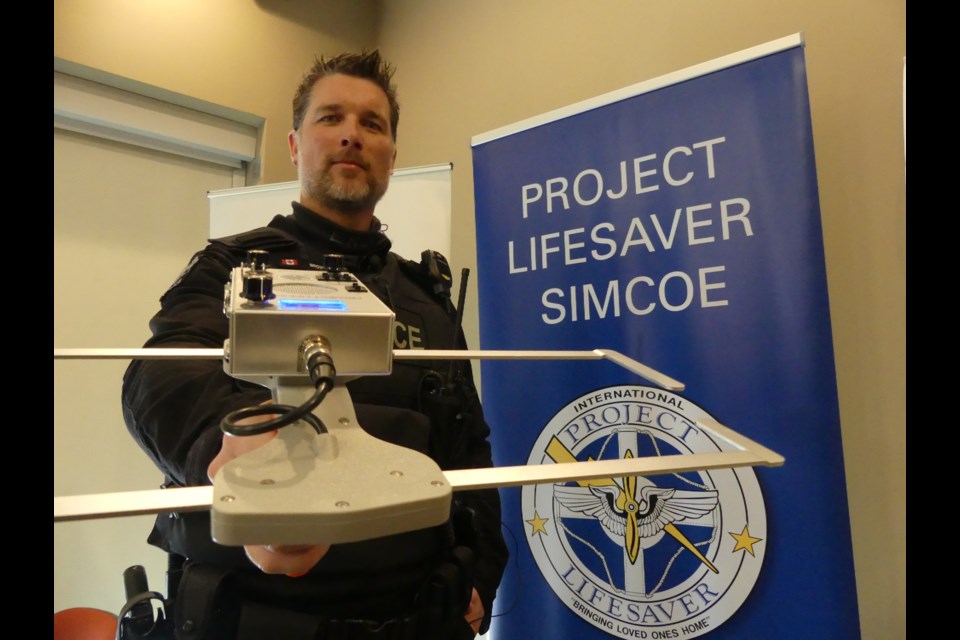Finding missing vulnerable people could go from taking hours to mere minutes, thanks to a new program launched Thursday by the South Simcoe Police.
The towns of Bradford West Gwillimbury and Innisfil each invested in the program to buy two Project Lifesaver Simcoe receivers and transmitters for US$3,500 each.
Families can sign up loved ones for a vulnerable people registry, and pay $500 for a bracelet that will transmit an FM signal to the police receiver if that individual wanders away and goes missing.
“Project Lifesaver Simcoe is another way we can help protect our most vulnerable citizens. Be it a youngster, a senior or anyone who goes missing, we know that time is the enemy,” said South Simcoe Police Chief Andrew Fletcher, adding the technology has helped reduce search times from hours to minutes.
“Last year, we had two seniors go missing in our area, prompting large-scale searches. Thankfully, in both of those situations, the individuals were found alive by alert and caring citizens and reunited with their families.”
But not everyone is so lucky, he added.
“We can’t imagine the agony of not knowing the whereabouts of a loved one, let alone losing them under such tragic circumstances. We hope the technology of Project Lifesaver Simcoe will help spare families from such an experience in the future.”
Although Project Lifesaver is being used in 19 locations around Ontario, South Simcoe Police and Barrie Police are the only two police services in Simcoe County to use the technology, but interest in growing, said Kris Hughston, co-founder of Project Lifesaver Simcoe.
York Regional Police offers Project Lifesaver in a community partnership with Alzheimer Society of York Region, Autism Ontario and Kerry's Place Autism Services, along with police volunteers.
York Region participants in Project Lifesaver pay a US$100 registration fee and a US$20 monthly fee.
If other communities do not have the technology needed to find a missing person, Fletcher added, South Simcoe, Barrie and York police services could step in to help.
“Thankfully in policing we know no boundaries,” he said.
Barrie Police launched Project Lifesaver in the city 10 months ago, but it has not yet had to use the technology.
“We’ve had searches (for missing people), but they wouldn’t have been on the (vulnerable people) registry,” said Jennett Mays, Barrie Police communications co-ordinator.
There are currently nine people on Barrie’s registry as part of Project Lifesaver, she said.
South Simcoe Police Const. Wes Brown is the local officer who will train his colleagues on how to use the Project Lifesaver technology.
In a demonstration Thursday, he showed how, when activated, the receiver — which looks like a walkie-talkie with rectangular wings on the sides and an orange handle underneath — will make a chirping sound that gets clearer the closer it gets to the transmitter.
The transmitter looks like a light grey watch with a grey cap over where a clock face would be.
Officers using the receivers to find someone would go to the last location where the person was seen, and do a slow 360-degree turn to see in which direction the chirping is strongest, before heading that way, Brown said.
The receivers also have an omni antenna, which can attach to the roof of a police car, and allow officers to drive around and pick up a signal within a nearly two-kilometre radius of the transmitter, he said, noting a person can wander up to about six kilometres an hour.
“We’d be listening for that chirp strength. We can cover a lot of ground very quickly,” he said.
The average nine-hour search for a missing person costs $1,500 an hour, Brown added, so “you can see that drastically reducing that time and expense to the communities and the taxpayers,” he said.
“It will bring peace of mind to the families of at-risk loved ones at home,” said BWG Mayor Rob Keffer. “It’s more than a wearable locating device. It’s a program that brings people together, brings the community together. Keeping loved ones safe is very, very important.”



